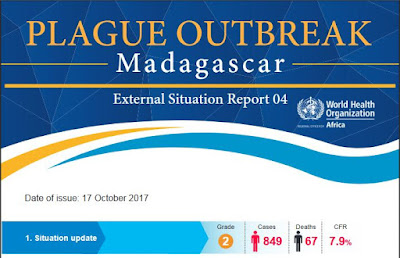#12,835
Although the numbers don't exactly align with those posted 2 days ago by Madagascar's MOH (see Confirmed & Suspected Plague Now Exceeds 800 Cases), today's update from the World Health Organization shows an increase of 164 cases between Oct. 13th and Oct. 15th.
The MOH report on the 16th showed fewer overall cases (n=805), but 6 more fatalities (n=73). Differences in data collection and cut off dates are likely behind these minor differences.Perhaps most significant is the jump in the number of health care workers who are reported to have contracted the plague. On October 12th, the WHO report listed 15 HCWs, while today's report references 39.
Some excerpts from today's WHO Situation Report #4:
Date of issue: 17 October 2017(Continue . . . )
Madagascar is experiencing a large outbreak of plague affecting major cities and other non-endemic areas since August 2017. Between 1 August and 15 October 2017, a total of 849 cases (suspected, probable and confirmed) including 67 deaths (case fatality rate 7.9%) have been reported from 37 (32.5%) out of 114 districts in the country. Of these, 568 cases (67%) were clinically classified as pneumonic plague, 155 (18.3%) were bubonic plague, one case was septicaemic plague, and 125 cases were unspecified. At least 39 healthcare workers have contracted plague since the beginning of the outbreak.
Of the 849 reported cases, 78 (9.2%) were confirmed, 304 (35.8%) were classified as probable after testing positive on rapid diagnostic tests (RDT) and 467 (55%) remain suspected. Eleven strains of Yersinia pestis have been isolated and were sensitive to antibiotics recommended by the National Program for the Control of Plague.
Eighteen (81.2%) out of 22 regions in the country, including traditionally non-endemic areas, have been affected. The district of Antananarivo Renivohitra has been the most affected, accounting for 57.1% of the reported cases. As of 16 October 2017, a total of 3745 contacts were identified, 79.2% (2 967) of them were followed up on the day of reporting.
Plague is endemic on the Plateaux of Madagascar, including Ankazobe District where the current outbreak originated. There is a seasonal upsurge, predominantly of the bubonic form, which occurs every year, usually between September and April. The plague season began earlier this year and the current outbreak is predominantly pneumonic and is affecting non-endemic areas including major urban centres such as Antananarivo (the capital city) and Toamasina (the port city).
There are three forms of plague, depending on the route of infection: bubonic, septicaemic and pneumonic (for more information, see the link http://www.who.int/mediacentre/factsheets/fs267/en/).
Meanwhile, the Seychelles MOH has announced that all suspected plague cases - including the index case - have tested negative.
Press Release: Update on Plague Alert
Regional overview and update
The Plague outbreak in Madagascar persists and is expanding into new areas. However, there is now a strong WHO and other partners’ support on the field that is doing active contact tracing and providing prophylaxis. About 3000 current contacts are on prophylaxis.
Mauritius has reported a suspected case but the person has since been tested negative and was discharged.
All countries in the region are on heightened surveillance and have issued travel advisory.
Local update
•All samples that were sent to Institut Pasteur Paris have been tested by using the PCR technique (Polymerase Chain Reaction). This was a confirmatory test and they were all NEGATIVE.
•All the patients who were isolated on the ward have now been discharged home, including the index case without any further risk. All admitted persons were on antibiotics, including second line.
•They can carry on with normal life as they do not have the plague.
•As of today all persons who were still on passive surveillance have completed their time and those who were still on antibiotics can stop.
People on active surveillance
•Last night four (4) Seychellois and one American were admitted at the Perseverance military academy. They had arrived through Mauritius from Madagascar. They are well and will remain there until 24th October. The American is leaving Seychelles today.
•Three (3) other Seychellois nationals who returned via Nairobi a week ago were released to go home this morning.
•A French national who left Madagascar on 13th October via Reunion will remain in the facility until tomorrow 19th of October.
•Two (2) Australians have also been discharged today.
•The Public Health Authority (PHA) continues to emphasise the advisory to discourage people from travelling to Madagascar for the time being. Anyone who has information that a Seychellois national is planning to travel to Madagascar should send a report to the Public Health authority or refer to CDCU.
•Hotline 141 is active and people can call for information and advice.
